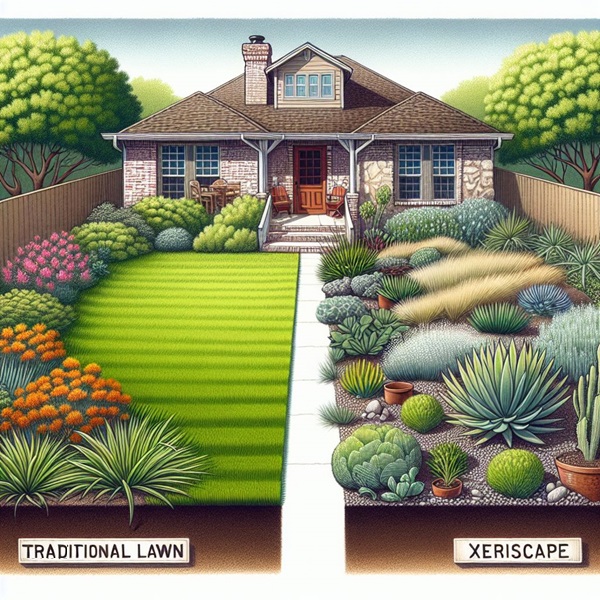
Key Takeaways
- Colorado’s xeriscape law encourages water-efficient landscaping to preserve the state’s precious resources.
- Properly removing your lawn involves several legal steps but leads to long-term environmental and financial benefits.
- Rebates and financial incentives are often available for Colorado residents who transition to
. - Selecting native and drought-resistant plants is crucial for a successful xeriscape garden in Colorado’s climate.
- Maintaining a xeriscape is easier and more cost-effective than traditional lawns, with less watering and upkeep required.
Mastering Colorado’s Xeriscape Laws
Are you thinking about switching to xeriscaping in Colorado? It’s a smart move for the environment and your wallet. But before you grab a shovel and start tearing up your lawn, you need to understand the local xeriscape laws and guidelines. These regulations are in place to ensure that your eco-friendly garden complies with state and local water conservation efforts.
Understanding Your Legal Obligations
First things first, let’s clarify what xeriscaping is. It’s a landscaping method that reduces or eliminates the need for supplemental water from irrigation. This is especially important in Colorado, where water is a precious commodity. The law here supports xeriscaping by allowing residents to replace water-thirsty lawns with drought-resistant plants and landscaping techniques that require minimal watering.
To legally remove your lawn and start a xeriscape garden, you’ll need to follow local guidelines. This may include obtaining permits, following water usage rules, and even notifying your homeowners’ association if applicable. It’s essential to get this right to avoid fines or legal issues down the road.
Grasping the Benefits of Xeriscaping
Now, you might be wondering, “Why go through all this trouble?” The benefits are plenty, including potential grants and rebates for residents in
- Water conservation: Xeriscaping can reduce your outdoor water use by up to 60%.
- Financial savings: Less water means lower utility bills, plus many areas offer rebates for xeriscaping.
- Time-saving: Xeriscape gardens require less maintenance than traditional lawns.
- Environmental impact: You’re helping to conserve water and support local ecosystems with native plants.
Because of these benefits, taking the time to plan and execute your xeriscape garden properly is well worth the effort.
Step-by-Step Lawn Conversion
Converting your lawn into a xeriscape garden is a process, but don’t worry, I’ll guide you through it step by step. Let’s roll up our sleeves and get started!
Preparation for Transition
Before you begin, it’s crucial to have a clear plan. This means understanding the size and layout of your yard, the amount of sunlight it receives, and the type of soil you have. You’ll also want to research the types of plants that will thrive in your specific conditions. Remember, the goal is to create a landscape that requires as little water as possible while still being vibrant and alive.
Lawn Removal Techniques
Once you’ve got your plan, it’s time to remove your existing lawn. There are a couple of ways to do this, including sustainable gardening techniques that are suitable for arid climates like Colorado.
Sod Cutter Usage: A sod cutter is a tool that removes the top layer of grass and roots, which you can then roll up and remove. It’s a quick method, but it requires some muscle and possibly a rental fee.
Sheet Mulching Method: This technique involves layering cardboard and mulch over your lawn, which eventually kills the grass and turns it into compost. It’s more eco-friendly and requires less physical labor, but it takes longer.
Both methods have their pros and cons, so choose the one that best suits your needs and timeline. For more detailed guidance on lawn removal and xeriscaping, consider exploring legal lawn removal guidelines.
Sod Cutter Usage
If you opt for a sod cutter, here’s what to do:
- Rent a sod cutter from your local hardware store or garden center.
- Mark any sprinkler heads or utility lines to avoid damaging them.
- Use the sod cutter to slice under the grass, then roll up the sod and dispose of it responsibly.
Sheet Mulching Method
For sheet mulching, follow these steps:
- Lay down cardboard or several layers of newspaper over your lawn.
- Wet the cardboard or newspaper to help it decompose.
- Cover it with a thick layer of mulch and wait for nature to do its work.
Regardless of the method you choose, remember that patience is key. Transitioning to a xeriscape garden is a journey, not a race.
Choosing the Right Xeriscape Plants
After clearing your space, the fun begins! Choosing the right plants is essential. In Colorado’s semi-arid climate, you’ll want to go for native species that are adapted to the local conditions. These plants will not only survive but thrive with minimal water. When selecting plants, consider their water needs, sunlight requirements, and how they’ll fit into your overall design.
Here are some top picks for Colorado xeriscapes:
- Blue Grama Grass: A native grass that’s drought-tolerant and provides a soft, natural look.
- Rocky Mountain Penstemon: This plant adds a pop of color with its purple flowers and is very low maintenance.
- Yucca: With its distinctive shape and resilience, yucca is a classic choice for xeriscapes.
- Prairie Coneflower: Bright and cheerful, these flowers attract pollinators and require little water.
- Sand Cherry: This shrub offers beautiful spring flowers and can handle tough conditions.
Remember to group plants with similar water needs together. This will make your watering routine more efficient and prevent over- or under-watering any of your plants.
Here is a data table with 3 columns and 5 rows on the topic of Colorado Xeriscape Law – Legal Lawn Removal Guide & Tips, with references as numbers and the corresponding links listed underneath:
| Requirement | Description | Reference |
|---|---|---|
| Lawn Removal Process | Homeowners must provide photographic evidence that the lawn has been removed at least 10 days before picking up any gardens from Resource Central. Lawn removal projects that started before receiving written approval are not eligible. | [1] |
| Xeriscape Design Guidelines | The Lowry Community Master Association (LCMA) in Denver has design guidelines that require property owners to obtain approval for any changes to the exterior of their buildings or grounds, including xeriscape landscaping. | [2] |
| Utility Discounts | Many Colorado water utilities offer discounts for lawn removal projects, reducing the cost from $2.50 per square foot to just $1.00 per square foot through Resource Central’s Lawn Removal Service. | [1] |
| Recommended Lawn Removal Methods | Recommended DIY lawn removal methods include using a sod cutter, sheet mulching, or solarizing the area. Chemicals are not recommended as they can negatively impact soil quality and insect health. | [1] |
| Xeriscape Landscape Requirements | After lawn removal, homeowners should cover the bare ground with at least 4 inches of mulch within a week to prevent weeds and grass from growing back. They should also be prepared to add low-water plants, trees, shrubs, gravel, or flagstone to create a new xeriscape landscape. | [1] |
References:
[1] https://coloradowaterwise.org/resources/Documents/State%20of%20Water%20Conservation%20in%20Colorado%202022/State%20of%20Colorado%20Conservation%20Report%20Final%2003.11.22.pdf
[2] https://www.durangoherald.com/articles/xeriscaping-trend-keeps-growing-in-durango/

Designing Your Xeriscape Space
Design is just as important as plant selection. A well-thought-out xeriscape garden can be just as lush and inviting as any traditional landscape. Keep in mind the principles of xeriscape design: planning and design, soil improvement, efficient irrigation, appropriate plant selection, mulch, maintenance, and the use of turf strategically.
Principles of Xeriscape Design
Good design starts with a vision. Imagine how you want your space to look and function. Do you want a cozy nook for reading? Maybe a space for outdoor dining? Or perhaps a habitat for local wildlife? Once you have your vision, draw it out. This will serve as your roadmap.
Improving your soil is next. Adding organic matter can greatly increase its water-holding capacity. In Colorado, soils can be clay-heavy and may need some amendment to get the best results.
Importance of Irrigation Planning
Water is precious, and efficient irrigation is a cornerstone of xeriscaping. Even though xeriscape plants are drought-tolerant, they still need water to establish themselves and survive long-term. Planning your irrigation system is therefore vital.
Most importantly, opt for irrigation methods that minimize water waste. Drip irrigation systems are a great choice because they deliver water directly to the plant roots, reducing evaporation and runoff.
Drip Irrigation Systems
Drip irrigation is a game-changer for xeriscapes. It’s a system of tubes and emitters that slowly release water near the base of each plant. This targeted approach means your plants get exactly what they need, and you don’t waste a drop.
- Choose quality components to avoid leaks and breaks.
- Install a timer to automate watering and ensure consistency.
- Regularly inspect the system for any issues.
Installing a drip system might seem daunting, but it’s a straightforward process that pays off in water savings and plant health.
Soil Moisture Monitoring
Alongside efficient irrigation, monitoring your soil’s moisture will help you water only when necessary. You can use a simple soil moisture probe or even just a screwdriver – if it goes into the soil easily, there’s enough moisture; if not, it’s time to water.
Post-Installation Care & Maintenance
Once your xeriscape is in place, it doesn’t mean your work is done. Regular maintenance is key to keeping your garden healthy and beautiful. This includes pruning, weeding, and monitoring plant health.
Efficient Watering Practices
Even with drought-tolerant plants, efficient watering is crucial. Water in the early morning or late evening to reduce evaporation. And when you do water, do it deeply and infrequently to encourage deep root growth, which helps plants become more drought-resistant.
Seasonal Plant Care
As the seasons change, so do the needs of your xeriscape garden. In spring, mulch your plants to conserve moisture and control weeds. Summer might require a bit more watering, depending on rainfall. Come fall, it’s time to prune and prepare your plants for winter. And in winter, although your garden is dormant, you might still need to water occasionally if conditions are particularly dry.
Interacting with Local Xeriscape Laws
As you’ve embraced xeriscaping, it’s important to stay informed about local regulations. Colorado is divided into various water districts, each with its own set of rules concerning xeriscaping. Ensure you’re in compliance by checking with your local water authority or city council.
County and City Regulations
Each county and city in Colorado might have specific regulations when it comes to xeriscaping. Some areas may have restrictions on the percentage of your yard that can be xeriscaped, or they may require certain plants. It’s essential to know these before you start planting.
Seeking Permits and Approvals
In some cases, you may need to obtain a permit before you begin converting your lawn. This is especially true if you’re planning significant changes to your property’s landscape. Additionally, if you’re part of a homeowners’ association, you’ll likely need to get your plans approved before moving forward.
- Check with your local government for any necessary permits.
- Present your xeriscape plan to your homeowners’ association for approval, if applicable.
- Ensure that your design complies with any local xeriscape incentives for a smoother approval process.
Following these steps will not only keep you within the law but may also expedite your xeriscaping project.
Financial Incentives and Resources
One of the biggest perks of xeriscaping in Colorado is the potential for financial incentives. Many local utilities offer rebates for residents who convert their traditional lawns into water-wise landscapes. These programs often reimburse a portion of the costs associated with xeriscaping, such as purchasing drought-tolerant plants or installing efficient irrigation systems.
Utility Rebate Programs
Utility rebate programs can significantly offset the initial investment in xeriscaping. For example, Denver Water offers a ‘Cash in on Grass’ rebate that provides customers with a rebate for every square foot of turf they replace with xeriscape. To take advantage of these programs, you’ll typically need to follow specific guidelines and submit an application, so be sure to do your research and apply.
Education and Community Support
Beyond financial incentives, Colorado offers a wealth of resources for those interested in xeriscaping. Local workshops, demonstration gardens, and online resources can provide you with the information and support you need to create a successful xeriscape garden. These resources can be invaluable for both beginners and experienced gardeners alike.
Creating an Eco-Conscious Community
By xeriscaping your property, you’re not just saving water; you’re also setting an example for your community. Sharing your success and the benefits you’ve experienced can inspire others to consider xeriscaping. Together, we can create a ripple effect that leads to a more sustainable and eco-conscious community.
Sharing Your Xeriscape Success
Don’t be shy about your xeriscape garden. Show it off! Whether it’s through social media, community events, or garden tours, sharing your xeriscape success can motivate others to follow suit. Your story can demonstrate the beauty and practicality of xeriscaping in a way that statistics and guidelines never could.
Engaging with Local Xeriscape Movements
There’s strength in numbers. Engaging with local xeriscape movements or environmental groups can amplify your impact. These organizations often lobby for water conservation measures, provide educational materials, and organize community projects. Getting involved can help push for broader adoption of xeriscaping principles and practices.
Data Table: Xeriscaping Your Lawn Essentials
| Action | Details | Benefits |
|---|---|---|
| Planning | Assess your yard’s conditions and design your xeriscape. | Creates a tailored approach that ensures success. |
| Lawn Removal | Choose between methods like sod cutting or sheet mulching. | Prepares the area for xeriscaping and reduces water use. |
| Plant Selection | Opt for native and drought-resistant plants. | Supports local ecosystems and conserves water. |
| Irrigation | Install efficient systems like drip irrigation. | Minimizes water waste and saves money. |
| Maintenance | Regular care like pruning and monitoring soil moisture. | Keeps your xeriscape healthy and thriving. |

FAQ: Navigating Colorado’s Xeriscape Law
Let’s address some common questions about xeriscaping in Colorado to clear up any confusion and help you move forward with confidence.
What is Xeriscaping and Why Does Colorado Focus on it?
Xeriscaping is a landscaping approach that reduces or eliminates the need for supplemental watering. Colorado focuses on it because it’s a state with semi-arid regions where water is a limited and valuable resource. By xeriscaping, residents can help conserve water and protect the environment.
How Do I Legally Remove My Lawn in Colorado?
To legally remove your lawn in Colorado, you should follow local guidelines and procedures, which may include obtaining permits or approvals, especially if you live in a community with a homeowners’ association. Always check with your local water authority or city council to ensure you’re in compliance.
Can I Get Financial Help for Xeriscaping My Property?
Yes, many utility companies in Colorado offer rebates and incentives for xeriscaping. These can cover a portion of the costs for plants, materials, and even professional design services. Check with your local utility provider to see what programs are available in your area.
Are There Penalties for Not Following Xeriscape Laws?
If you don’t follow the xeriscape laws and guidelines in Colorado, you could face penalties, which can include fines or being required to undo any non-compliant landscaping. It’s essential to understand and adhere to local xeriscape regulations to avoid these consequences.
With the increasing need for water conservation, many homeowners are turning to xeriscaping as a sustainable landscaping solution. Not only does xeriscaping save on water consumption, but it also reduces maintenance needs and can be beautifully designed with the right selection of drought-resistant plants and decorative elements.



